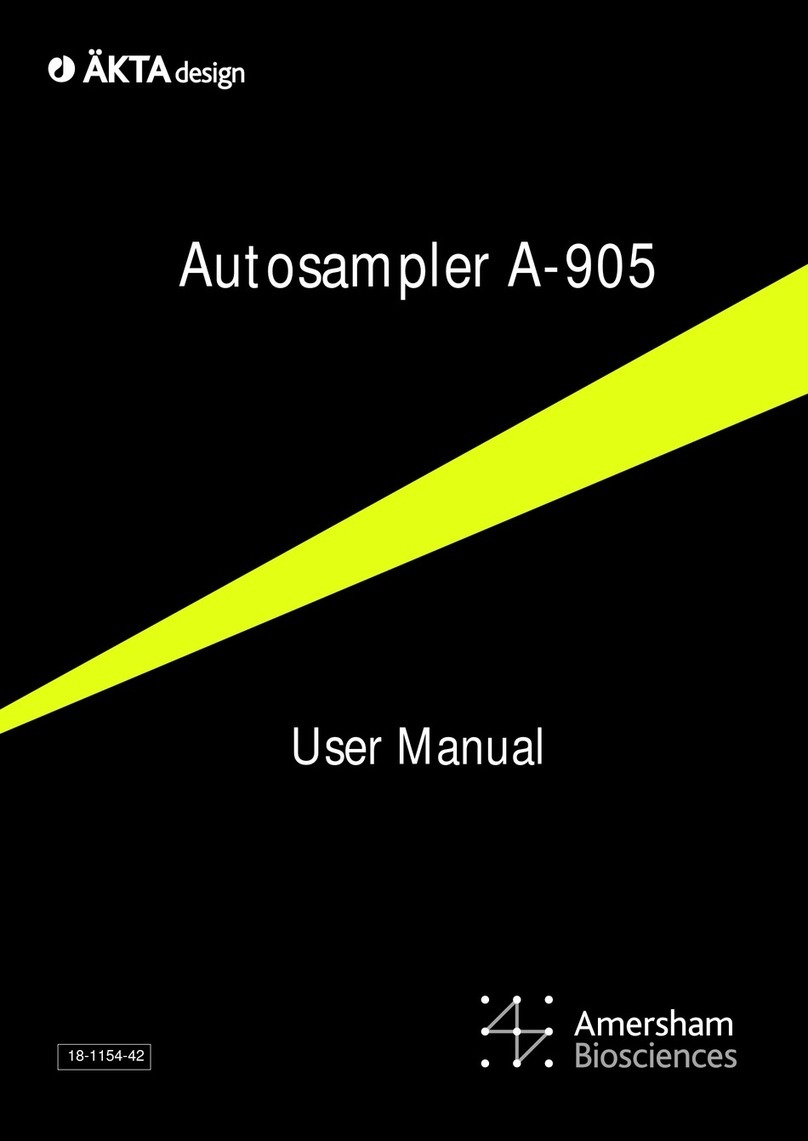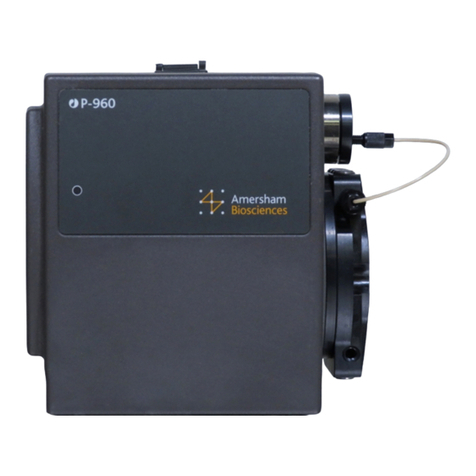
Hoefer DALT System
Amersham Biosciences
Renseignements importants
d’utilization
Pour une bonne compréhension et une utilisation
en sécurité maximale, il convient de lire entièrement ce manuel.
Dans la documentation qui accompagne l’instrument un point d’excla-
mation dans un triangle équilatéral a pour but d’attirer l’attention de
l’utilisateur sur des instructions importantes de fonctionnment ou de
maintenance.
Tous vos commentaires sur ce manuel seront les bienvenus et veuillez les adresser
à:
Amersham Biosciences Inc.
Marketing Department
654 Minnesota Street
San Francisco, CA 94107 USA
Amersham Biosciences seréserveledroitd’effectuerdesmodificationsde
ces spécifications sans aucun préavis.
Garantieet responsabilité
Amersham Biosciences garantit àl’utilisateurqueleproduitlivréa subi
avec succèstouslesessaisprévuspours’assurerqu’il estconforme aux spécifica-
tionsetnormesenvigueur. Lagarantieinclusedanslesconditionsdelivraison
n’est valablequesi leproduit a étéinstalléetutiliséconformément aux instruc-
tions fournies parAmershamBiosciences.
Lasociété AmershamBiosciences nesera enaucuncasresponsable de
tout dommagecausédirectementouindirectementpartouteutilisation incor-
recteou nonapprouvée du produit oudécoulant decetteutilisation, y compris
toute perte de bénéfice ou de recettes, toute perte de perspectives commerciales,
tout empêchement d’utilisation ettoutautrerisquesayantunrapportavec l’util-
isation du produit, mais sans aucune limitation quant à la nature de ces
dommages.
©1998AmershamBiosciences Limited.
Tous droits réservés.
La reproduction, le stockage dans un système de récupération d’informations ou
la transmission sous quelque forme que ce soit et par quelque moyen que ce soit
de la présente publication en totalité ou en partie sont strictement interdits sans
autorisation préalable écrite de la société.
Información importante para el usuario
Para comprender el producto y utilizarlo con segu-
ridad es necesario leer este manual en su totalidad.
El signo de admiración en un triángulo
equilátero en el manual, advierte al usuario sobre la presencia de
instrucciones importantes de operación y mantenimiento del aparato.
Si desearan hacer algún comentario sobre este manual, tengan la amabilidad de
remitirlo a:
Amersham Biosciences Inc.
Marketing Department
654 Minnesota Street
San Francisco, CA 94107 USA
Amersham Biosciences sereserva el derecho amodificarlasespecifica-
ciones sin previo aviso.
Garantía y responsabilidad
Amersham Biosciences garantizaqueel productoentregado hasidopro-
badoafondo paracomprobarelcumplimientodelas especificacionespublica-
das. La garantía incluida en las condiciones de entrega sólo es válida si el
producto se ha instalado y utilizado de acuerdo con las instrucciones entregadas
porAmersham Biosciences.
Amersham Biosciences noseráresponsable, bajo ningún concepto, de
daños directos o indirectos, incluyendo sin limitación la pérdida de beneficios, la
pérdida de ingresos, la pérdida de oportunidades de negocio, la pérdida de uti-
lización y otras consecuencias relacionadas, cualquiera que sea la causa, que se
deban a lautilización defectuosaeincorrecta del producto.
©1998Amersham Biosciences Limited.Reservadostodos
los derechos.
No está permitida la reproducción, ni el almacenaje en un sistema de recuper-
ación, ni la transmisión de parte alguna de esta publicación sin la autorización
por escrito de la empresa.
Wichtige Benutzerinformationen
Für ein vollständiges Verständnis und eine sichere
Handhabung dieses Produktes ist es notwendig, daß
der Benutzer dieses Handbuch vollständig durchliest.
Ein Ausrufezeichen in einem gleichseitigen Dreieck soll den
Benutzer auf die Anwesenheit wichtiger Betriebs- und Wartungsan-
weisungen in der dem Gerät beiliegenden Dokumentation hin-
weisen.
Wenn Sie Anmerkungen zu diesem Handbuch haben, dann senden Sie diese bitte
an:
Amersham Biosciences Inc.
Marketing Department
654 Minnesota Street
San Francisco, CA94107 USA
AmershamBiosciences behältsichdas Rechtvor,die Spezifikationen
ohne vorhergehende Ankündigung zu ändern.
Gewährleistung and Haftung
Amersham Biosciences garantiert, daß dasgelieferte Produkt sorgfältig
aufdieEinhaltungderveröffentlichtenSpezifikationen getestetwurde.Diein
den Lieferbedingungen näher erläuterten Gewährleistungsansprüche gelten nur
dann,wenn dasProdukt gemäß denvon AmershamBiosciences
geliefertenAnweisungeninstalliertund benutzt wurde.
Amersham Biosciencces übernimmt keinerlei Haftung fürSchädenoder
Folgeschäden, einschließlich, aber nicht begrenzt auf Gewinneinbußen, Einkom-
mensverluste,entgangeneGeschäftsabschlüsse,VerlustderGebrauchsfähigkeit
oder andere Verluste, die wie auch immer durch eine fehlerhafte oder
unsachgemäßeVerwendung desProduktsverursachtwurden.
©1998AmershamBiosciences Limited.
Alle Rechte vorbehalten.
Die vorliegende Veröffentlichung darf nur mit vorhergehender schriftlicher Gene-
hmigung durch das Unternehmen vervielfältigt, in einem Abrufsystem gespe-
ichertoderin irgendeinerForm odermit irgendwelchenMitteln übertragen
werden.
Informazioni importanti per l’operatore
Per un utilizzo sicuro del prodotto, leggere attentam-
ente l’intero contenuto del presente manuale.
Il punto esclamativo all’interno di un
triangolo equilatero indica all’operatore la presenza di importanti
istruzioni di funzionamento e manutenzione nella documentazione
allegata al prodotto.
Si prega di inviare eventualicommential presentemanuale a:
Amersham Biosciences Inc.
Marketing Department
654 Minnesota Street
San Francisco, CA 94107 USA
Amersham Biosciecnes si riserva il dirittodi apportaremodificheai dati
tecnici senza preavviso.
Garanziae responsabilitá
Amersham Biosciences garantiscecheprimadellaconsegna il prodottoè
stato collaudato a fondo per soddisfare i requisiti specificati. La garanzia inclusa
nelle condizioni di consegna risulta valida solamente se il prodotto è stato instal-
lato edutilizzatonel rispetto delleistruzioni fornitedaAmersham
Biosciences
Amersham Biosciences non potrà essereritenuta responsabiledi incidenti
o danni consequenziali, inclusi’ma non limitati’a perdite di profitti, mancato
guadagno, perditedi affari,difetti di funzionamento erelativeesposizioni, dovuti
ad un utilizzo non corretto del prodotto.
©1998AmershamBiosciences Limited.
Tutti i diritti riservati.
Nessuna parte della presente pubblicazione può essere riprodotta, conservata in
sistemi di gestione dati o trasmessa in alcun forma né per nessuno scopo senza
autorizzazione scritta del produttore.
Français
Español
Deutsch
Italiano
































